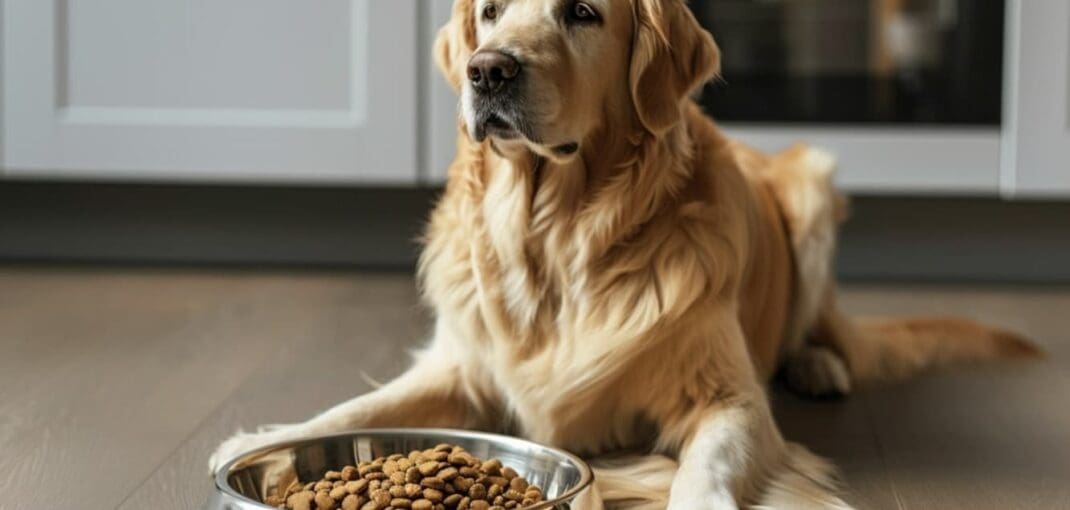Choosing the right food for your dog is one of the most important parts of looking after your pet, especially when it comes to large breeds. Do you know how much a large dog should eat to stay healthy and energetic on a daily basis? A balanced diet is the key to his well-being and long life. That’s why we have prepared this article to help you understand the specific nutritional needs of larger pets and choose the ideal solution for your pet.
In the following text, you will find practical tips on how to calculate your dog’s daily food intake so that you can provide him with the right amount of calories and nutrients. We will also discuss which type of food best suits the needs of large dogs, taking into account their physical activity, age and health status.
Every pet is different, so take a moment to analyse their needs and behaviour. A large dog’s diet should not only be balanced, but also tailored to its individual requirements – from the right food composition to the right portion size.
Read on to find out step by step how to ensure a balanced diet for a large dog and create the optimum conditions for your pet to enjoy energy and health every day!
How much food does a large dog need? Basic principles of nutrition.
Large dogs such as German Shepherds, Labradors, Rottweilers and St. Bernards have higher calorie requirements than smaller breeds, but this does not mean that they can be fed ‘by eye’. The appropriate food portion should be appropriate to the dog’s weight, age, activity level and general health. Portions that are too large can lead to overweight, while portions that are too small can lead to malnutrition and health problems. So what should be the daily food intake for a large breed dog?
For example, for a German Shepherd weighing 40-45 kg, the daily food ration could be between 800 and 1,200 grams, depending on the type of food and activity level. Similarly, St Bernards, which reach weights of up to 70 kg, need large portions, but their diet should be particularly well balanced due to their tendency towards joint problems.
When considering how much a large dog should eat, bear in mind that nutritional standards take into account differences between products. Wet dog food contains more water than dry food, so portions naturally need to be larger in volume.
Don’t forget the quality of the food you feed your dog either. A good diet for a large dog such as a golden retriever is one that provides all the necessary nutrients in the right proportions, without unnecessary fillers. Products from reputable manufacturers such as Dolina Noteci, especially specialised foods for large breeds, are tailored to their specific needs.
How do you calculate the daily food ration for a large dog?
Calculating the daily food intake for a large dog requires consideration of the dog’s body weight, activity level and individual metabolic needs. In the case of large breed dogs such as the German dog, leonberger, English mastiff or Caucasian Shepherd, caloric requirements are not a simple ratio to body weight. This is because these dogs have different metabolic levels and their energy requirements differ from small breeds.
Large breed dogs of normal body weight and moderate physical activity have caloric requirements in the range of 2,100 to 2,300 kcal per day. The final calorie count depends on:
Level of physical activity (e.g. a working dog will need more calories than a house dog).
Life stage (puppy, adult dog, senior dog).
Individual characteristics of the dog, such as metabolism or health status.
Remember that the dosage of food for a large dog should follow the nutritional chart on the food packaging, but you can always consult your vet to adjust the portions to suit your pet’s individual needs. Remember also that dry dog food is always more substantial than wet food. Consequently, you must be careful about the size of the portions you give your pet.
How many times a day to feed a large dog? Determine the optimum schedule.
Once you know how much a large dog should eat, also check how it should be fed. Dividing meals into smaller portions served several times a day is key when feeding large dogs. Due to their propensity for stomach torsion, which can occur after too much of a single meal, it is recommended to feed them 2-3 times a day. This reduces the risk of health problems and the dog has a consistent level of energy throughout the day.
So how many times a day should you feed a large dog? Puppies and young dogs should be fed more often – up to four times a day, while adult dogs can be given 2-3 meals a day. Seniors, especially those with reduced activity, may need smaller but more frequent portions to avoid stress on the digestive system. When doing so, remember that the regularity of meals is as important as the size of the meal.
Wet or dry food for a large dog? Find out the best options:
The choice between wet and dry food depends on the individual needs of the dog and the preferences of the carer. Dry food is more convenient to store, more economical and effectively promotes oral hygiene by helping to remove tartar. It is also more calorically concentrated, meaning portions can be smaller.
The wet food, on the other hand, is more flavoursome and easy to digest, making it a good choice for dogs with sensitive stomachs or those who have difficulty chewing. It offers a higher water content, which helps to keep the body hydrated, especially in dogs who drink little.
It may be best to combine both types of food to take advantage of their benefits. Dried treats can also be an interesting addition to the diet. Dried dog food is packed full of valuable nutrients and in a form that guarantees a great taste, which often attracts the attention of even the biggest of non-eaters.
What to avoid in feeding large dogs?
Serving leftover food from the human table is one of the most common traps dog guardians fall into. Such foods may contain spices, fats or ingredients that are harmful to the pet, such as onions or chocolate. In addition, it is not possible to determine precisely how much a large dog should eat when you feed or feed him leftovers.
Inadequate dosage of food can also be a problem. Portions that are too large can lead to overweight, which increases the risk of joint and cardiovascular disease. Conversely, too small amounts can cause nutrient deficiencies.
Also remember to avoid low-quality foods that contain high amounts of cereals, artificial additives and by-products. Your dog’s daily food intake should come from quality sources such as high-quality meat, healthy fats and natural additives to support your pet’s health.
Remember to always tailor meals to your pet’s individual needs and follow the nutritional standards for large dogs, which take into account their weight, age and activity level. Take care of your dog today and reach out for proven tips and products to ensure a balanced diet!






